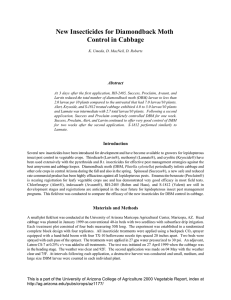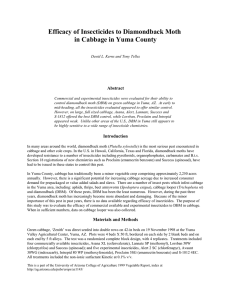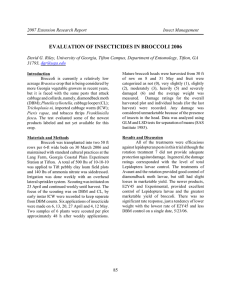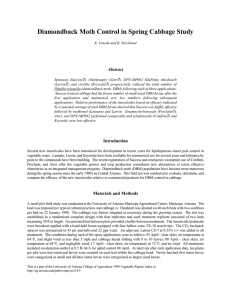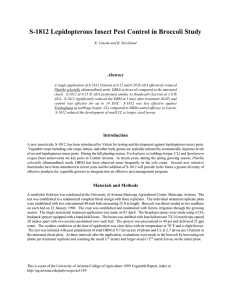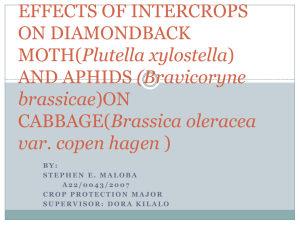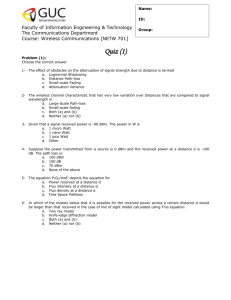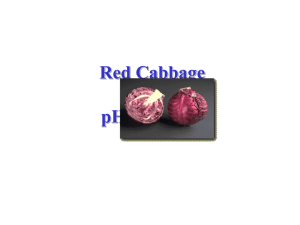Diamondback Moth Control in Spring Cabbage Abstract
advertisement
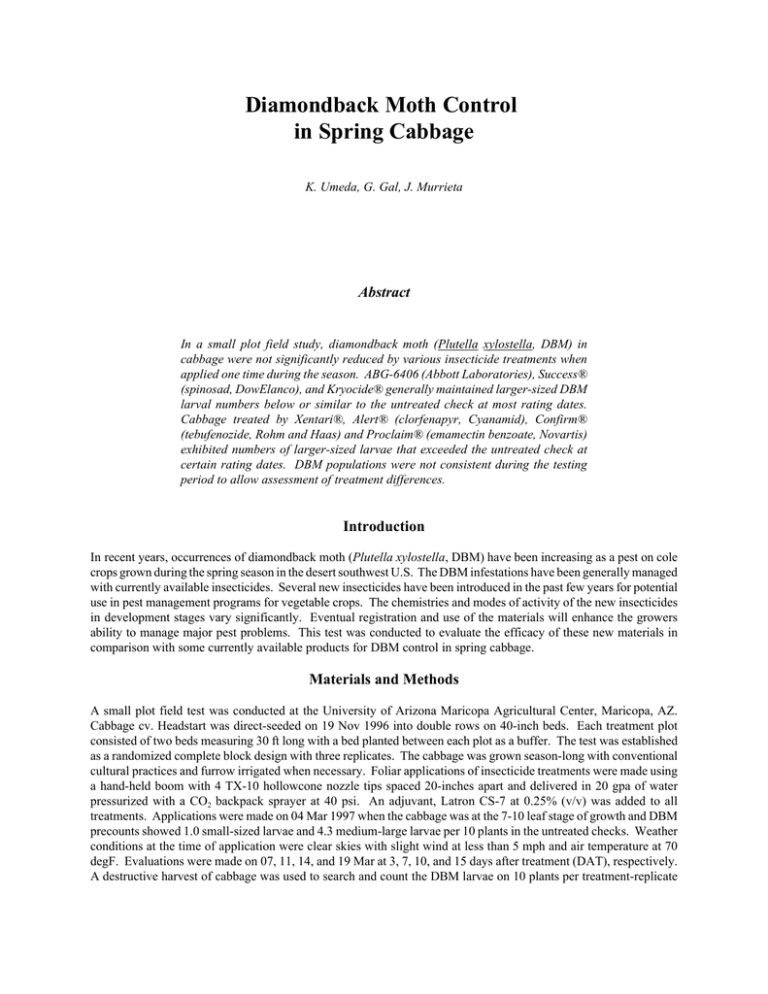
Diamondback Moth Control in Spring Cabbage K. Umeda, G. Gal, J. Murrieta Abstract In a small plot field study, diamondback moth (Plutella xylostella, DBM) in cabbage were not significantly reduced by various insecticide treatments when applied one time during the season. ABG-6406 (Abbott Laboratories), Success® (spinosad, DowElanco), and Kryocide® generally maintained larger-sized DBM larval numbers below or similar to the untreated check at most rating dates. Cabbage treated by Xentari®, Alert® (clorfenapyr, Cyanamid), Confirm® (tebufenozide, Rohm and Haas) and Proclaim® (emamectin benzoate, Novartis) exhibited numbers of larger-sized larvae that exceeded the untreated check at certain rating dates. DBM populations were not consistent during the testing period to allow assessment of treatment differences. Introduction In recent years, occurrences of diamondback moth (Plutella xylostella, DBM) have been increasing as a pest on cole crops grown during the spring season in the desert southwest U.S. The DBM infestations have been generally managed with currently available insecticides. Several new insecticides have been introduced in the past few years for potential use in pest management programs for vegetable crops. The chemistries and modes of activity of the new insecticides in development stages vary significantly. Eventual registration and use of the materials will enhance the growers ability to manage major pest problems. This test was conducted to evaluate the efficacy of these new materials in comparison with some currently available products for DBM control in spring cabbage. Materials and Methods A small plot field test was conducted at the University of Arizona Maricopa Agricultural Center, Maricopa, AZ. Cabbage cv. Headstart was direct-seeded on 19 Nov 1996 into double rows on 40-inch beds. Each treatment plot consisted of two beds measuring 30 ft long with a bed planted between each plot as a buffer. The test was established as a randomized complete block design with three replicates. The cabbage was grown season-long with conventional cultural practices and furrow irrigated when necessary. Foliar applications of insecticide treatments were made using a hand-held boom with 4 TX-10 hollowcone nozzle tips spaced 20-inches apart and delivered in 20 gpa of water pressurized with a CO2 backpack sprayer at 40 psi. An adjuvant, Latron CS-7 at 0.25% (v/v) was added to all treatments. Applications were made on 04 Mar 1997 when the cabbage was at the 7-10 leaf stage of growth and DBM precounts showed 1.0 small-sized larvae and 4.3 medium-large larvae per 10 plants in the untreated checks. Weather conditions at the time of application were clear skies with slight wind at less than 5 mph and air temperature at 70 degF. Evaluations were made on 07, 11, 14, and 19 Mar at 3, 7, 10, and 15 days after treatment (DAT), respectively. A destructive harvest of cabbage was used to search and count the DBM larvae on 10 plants per treatment-replicate at each date. Small (1st and 2nd instar) and medium-large (3rd instar or larger) larvae were counted and data was analyzed . Results and Discussion Following a single application, the mean DBM larval counts were not significantly different among all treatments. The number of small larvae per 10 plants ranged from 0.3 to 2.3 at the precount through the 15 days after treatment (DAT). Larger-sized larvae ranged from 0.7 to 2.0 larvae per 10 plants at 3 DAT then increased to range as high as 7.0 larvae per 10 plants after 7 DAT. Cabbage treated by Xentari, Alert, Confirm, and Proclaim exhibited numbers of larger-sized larvae that exceeded the untreated check at certain rating dates. ABG-6406, Success, and Kryocide generally maintained DBM larval numbers below or similar to the untreated check at most rating dates. The low infestation of DBM in the cabbage did not allow for better separation of mean numbers per 10 plants. A trend appeared at later rating dates where increased numbers of DBM were detected for treatments but the untreated cabbage did not show a progressive population increase. Treatments did not effectively reduce the DBM to significant levels below the untreated check. Coverage at application may not have been adequate at 20 gpa on the cabbage having 7-10 leaves. Multiple applications of the treatments could offer improved DBM control and smaller-sized larvae could be more susceptible than larger larvae to earlier timed applications in future testing . Table. Diamondback moth control in spring cabbage, 1997. (Umeda, Gal, Murrieta) Treatment Untreated check Xentari ABG-6406 Alert Confirm Proclaim Success Kryocide LSD (p=0.05) Rate (lb AI/A) 1.0 1.0 0.1 0.125 0.0075 0.09 7.7 Mean DBM larvae/10 plants 04 Mar 07 Mar 11 Mar 14 Mar 19 Mar 04 Mar 07 Mar 11 Mar 14 Mar 19 Mar ---------------------- small -------------------------------------- ------------------------medium/large -------------------------1.0 0.3 1.0 1.0 0.7 4.3 1.7 5.0 4.3 3.3 1.3 0.7 1.3 0.3 2.0 7.0 2.7 6.3 1.0 1.0 0.7 0.7 0.7 3.3 1.3 2.7 0.7 0.3 2.0 2.3 2.0 3.3 5.3 4.3 0.3 1.0 2.3 2.0 2.0 1.7 3.3 5.3 1.3 0.7 0.7 1.0 1.3 2.7 4.3 6.3 1.0 0.3 0.3 1.7 1.7 3.0 3.7 3.3 0.3 0.3 1.0 1.7 1.3 4.0 3.7 3.3 1.7 1.9 2.6 1.6 1.4 4.8 3.8 4.3
